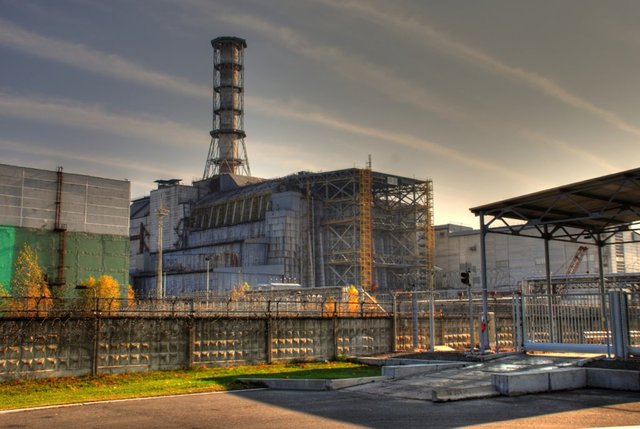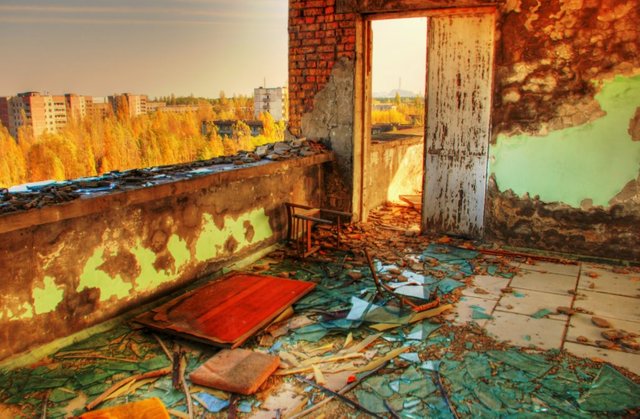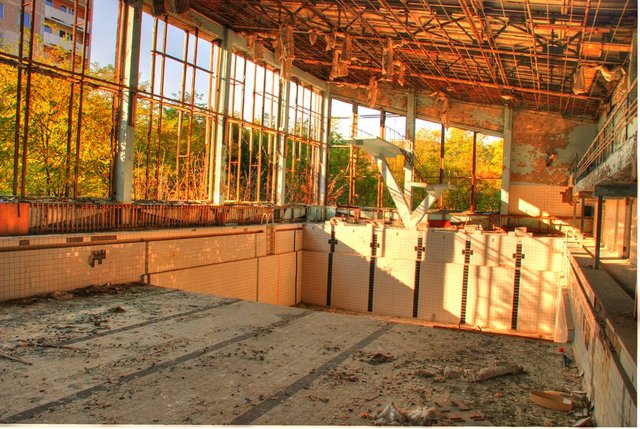A visit to Chernobyl
The three of us were about to enter the highly restricted exclusion zone around Chernobyl's reactor. Myself, a science teacher friend, and our guide - Yuri, in his noisy Lada, complete with pine cone air freshener hanging from the mirror. We'd taken an overnight train from Rzezow in Poland to Kiev, the capital of Ukraine, where Yuri had picked us up this morning. A two hour drive through the countryside with Yuri regaling us with his facts and figures about Chernobyl, his life and his country, and we were at the first check-point.
Twenty two years ago the nuclear power plant at Chernobyl's unassumingly-titled Reactor Number Four exploded, sending a radioactive plume of toxic fallout west across Europe - four hundred times more than than released in the bombing of Hiroshima. Today, a thirty mile exclusion zone, with armed guards, surrounds an inner ring with additional guards ten miles from the reactor, and inside that zone - once home to the thriving city of Pripyat, and many smaller villages - there is nobody. We were about to change that.
At this point our car was given a half-hearted search by security while we stared wide-eyed at their weapons and the many Cyrillic warning signs. The only word we could translate was "Stop", with an ominous radiation symbol beneath. Then we were through, and a short time later repeated the procedure at the inner ring. At this point Yuri presented us with a Geiger counter to measure the radiation levels, with numbers that my science teacher friend understood, while I just worried over the ever-increasing speed of the "bip-bip-bip" coming from it.
As the tops of the reactor towers started to appear in the distance, we stopped to look at some mounds at the side of the road. These, Yuri explained, were once houses, buried by the government to prevent people from returning, and each with a radiation sign in them. Dutifully we moved the Geiger closer, and it responded by doubling its pace. We backed off.
A few minutes later and we were in sight of the infamous reactor itself. When it blew, firefighters gave their lives dropping water, sand and concrete onto the blaze in an effort to create a "shelter" (though the media termed it the "sarcophagus") and hopefully prevent further leaking. Today the monstrous sides are cracking and crumbling; the wear and tear is certainly evident - both visually and by the frantic sounds from the Geiger as we stood not four hundred yards from the site of the world's worst ever nuclear power plant disaster.

We moved away and crossed over the "Bridge of Death" nearby, where people had stood to look directly into the glowing, melting core, not knowing that they would die within weeks from radiation poisoning. It was a sobering sight, and entering the abandoned city of Pripyat did nothing to improve the scene. At the time, the purpose-built town held fifty thousand residents, all of whom were evacuated in a rush and told to leave everything as it was, for they could return within three days, then a week, then a month. They have yet to return.

The town at the time was going through a building boom, with the new school in place, hotels, and a new restaurant and theme park due to open in days. Now the main hotel has no windows, and a lone tree grows out of the cracks on the eighth floor. The central supermarket looks like a small tornado was born within it, with vandals having long ago taken anything of value. The hand prints of handball players still show on the wall of the gym, and the pool stands empty, the diving board lying abandoned by the edge.

Outside, the now semi-legendary theme park is deserted. The bumper car arena has weeds all the way through, and a canoe-swing lies where someone had dragged it in the middle of the park. All around us it is eerily silent, save for the faint cry of a wild pig. Yuri tells us that some wildlife has returned, with pigs, foxes and even moose spotted in the area.
Inside the school, classrooms were left with books on desks, tools lying where wood-working students left them, and the library was a mess of rotting books, their shelves long pushed over by vandals. A single newspaper lay on a desk, rather conveniently dated from the day of the explosion. On the board were drill instructions for gas leaks, and instructions on assembling a Kalashnikov assault rifle.
Trundling back out in Yuri's faithful Lada, we pondered over what we'd just experienced. A ghost city, the legacy of a tragedy that affected so many, destroying lives and ruining the collective hope and dreams of a city and its people, now just a skeleton of its former self. Fewer than five thousand people enter into the exclusion zone each year. Radiation is still at a critical level in the reactor though, and while short exposure in the surrounding area is sufficiently safe, any prolonged stay incurs a serious risk. But as we went through the radiation scanners and stopped at Yuri's office for some food just outside the inner border (all food is brought in from Kiev), we could see changes around us. New above-ground water pipes snaked their way around - it's considered too great a risk to put them underground. Scientists now enter the area occasionally, and some residents have applied to return to their homes, even two decades on. Animals have apparently thrived upon their return, and ornithologists have even observed birds flying in and out of a crack in the reactor's sarcophagus, seemingly indicating a nest inside. More than two decades after that fateful day, against all the odds, life goes on.